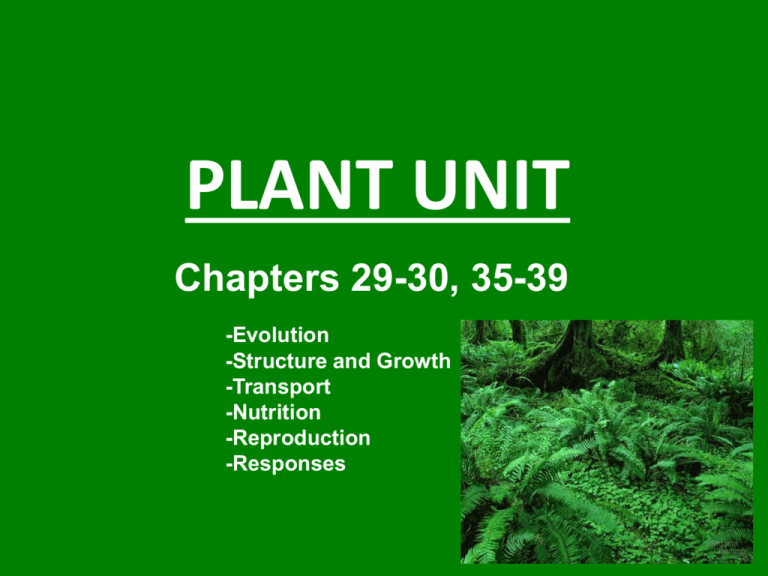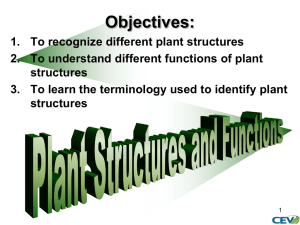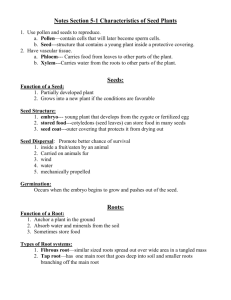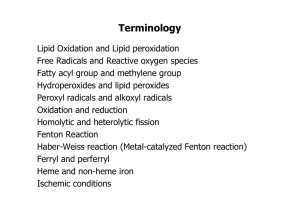Unit 13 Plants (Teacher) PPT
advertisement

PLANT UNIT Chapters 29-30, 35-39 -Evolution -Structure and Growth -Transport -Nutrition -Reproduction -Responses EVOLUTION Land Plants Spores Seeds Alternation of Generations Water Management Vascular Tissue Xylem Cell Evolution Secondary Compounds Bryophytes Pteridophytes Gymnosperms Angiosperms Monocot and Dicot PLANT STRUCTURE Leaf Stem Root 3 Tissues: -Ground -Dermal -Vascular Ground Tissue (thickness of cell wall) Thinnest Thickest 1.Parenchyma Cells = storage, photo, secretion 2.Collenchyma Cells = mechanical support 3.Sclerenchyma Cells = mechanical support Dermal Tissue Epidermal cells, guard cells/stomata, specialized cells (hair cells, stinging cells, glandular cells) Alkyl Groups (C-H) C6H4(OH)2 Urushiol oil R = (CH2)14CH3 or R = (CH2)7CH=CH(CH2)5CH3 or R = (CH2)7CH=CHCH2CH=CH(CH2)2CH3 or R = (CH2)7CH=CHCH2CH=CHCH=CHCH3 or R = (CH2)7CH=CHCH2CH=CHCH2CH=CH2 Vascular Tissue Xylem = transport water and minerals, provide mechanical support Phloem = transport sugar Xylem Vascular Bundles Tracheids Vessel Elements Secondary Cell Wall = Strength Dead at maturity (no components) Phloem Sieve-Tube Members Sieve-Tubes Plasmodesmata Perforations = more efficient Living at maturity No Nuclei or Ribosomes Companion Cell =parenchyma cell that provides physiological support to sieve-tube member PLANT GROWTH The Seed Seed Coat Embryo Endosperm or Cotyledons (digested endosperm) Epicotyl (shoot tip) Radicle (root) Hypocotyl (shoot) Plumule (leaves) Cotyledon Seed to Seedling SAM (Shoot Apical Meristem) Negative Gravitropism Dormancy = environmental cues (water, temp, light, fire, ingestion) Imbibition (absorption) of water Initiates enzymes biochemical pathways Seed coat swells and cracks Radicle Hypocotyl elongation RAM (Root Apical Meristem) Water Gibberellins (GA) hormones Aleurone (outer endosperm) Amylase Growth Positive Gravitropism (Auxin) Xylem/ Pholem Parenchyma Epidermal Differentiation PRIMARY GROWTH vs. SECONDARY GROWTH Primary Growth - vertical growth -apical meristems Secondary Growth -lateral growth (girth) -lateral meristems -“cambium” Primary Structure of Roots Casparian Strip (Suberin/wax) Lateral Root from Pericycle Primary Structure of Stems Cutin (wax) Secondary Structure of Stems Primary Structure of Leaves Cutin (waxy) TRANSPORT IN PLANTS Xylem Sap Transport (Evapotranspiration) Only Symplast Nitrates Cohesion-Tension Theory (most water movement) -transpiration (negative pressure/ tension in leaves) -cohesion (hydrogen bonds between water) -bulk flow (evaporation from leaf pulls the column) Capillary Action -rise of liquids in narrow tubes -adhesion Into Xylem = “Root Pressure” - seen in “guttation” Into root = Osmosis -movement of water root stem -mineral concentration in stele Leaf Draw (Pull) Guard Cells -cell walls not uniform thickness -cellulose microfibrils arrranged radially -water diffuses in -thinner cell wall expands more -create the stoma (opening) Stomata open at dawn – dusk Three cues: 1. Light stimulates guard cells to accumulate K+ ions (blue light receptors H+ pump) Light drives photosynthesis making ATP available 2. Depletion of CO2 in air spaces of the leaf 3. “Internal clock” in guard cells Circadian rhythm K+ Ions -active uptake (H+ membrane potential) -water potential change TRANSLOCATION OF PHLOEM SAP Source – Sink (Pressure Flow) 1. Soluble carbohydrates (sucrose) Palisade mesophyll (source) Sieve-tube Active transport 2. Solute concentration gradient Water diffuses into sieve-tube 3. Pressure potential increases Bulk flow through sieve-tubes 4. Pressure begins to build at sink Carbohydrates are being utilized at sink Sugars removed from sieve-tube (active) Decrease solute concentration Water diffuses out relieving the pressure apoplast Loading of sucrose into phloem symplast Transpiration Adaptations Xerophytic Leaf (sunken stoma) C4 and CAM Adaptations Plant Nutrients Flower Reproduction Pollination UV light Fruits Seed Development Seed Dispersal Seedling Growth Ecological Impact Agriculture And Medicinal Use Human Abuse Deforestation Plant Responses (Hormones) Plant Hormone Overview







